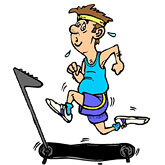A Sweaty Subject
 When human body temperature rises, tiny muscles around the sweat glands in the skin contract, squeezing perspiration - better known as sweat - out through the pores. Sweat is about 99 percent water. Dissolved in it are salts of sodium, potassium, and magnesium. Sweat also contains tiny amounts of waste materials such as urea (the major toxin in urine).
When human body temperature rises, tiny muscles around the sweat glands in the skin contract, squeezing perspiration - better known as sweat - out through the pores. Sweat is about 99 percent water. Dissolved in it are salts of sodium, potassium, and magnesium. Sweat also contains tiny amounts of waste materials such as urea (the major toxin in urine).
The skin of an adult contains some three to five million sweat glands, the combined total of two different types. Most abundant are the eccrine glands. About two million of them are distributed over the entire body. These glands empty directly onto the skin through pores. They help control body temperature and excrete waste material. The eccrine glands handle the body's heat-regulating functions. Exercise increases both the size and the efficiency of eccrine sweat glands. People who start an exercise program often notice that, after a few weeks, they start sweating at a lower body temperature and come to tolerate heat better.
The second kind, the apocrine glands, are inactive in childhood. They begin to work between the ages of 10 and 14 when the production of sex hormones increases. They empty into hair follicles, mostly in the armpits and groin. They produce a thick, colored fluid containing a complex mixture of fats, water, and proteins. The apocrine glands are especially sensitive to emotions. Antiperspirants work only on the apocrine glands. Perspiration itself is odorless, whether it comes from apocrine or eccrine glands. It's only when bacteria grow in sweaty places, such as under the arms, that odor occurs.
About the Author
Faith Brynie, Ph D
 Faith Brynie holds a B.A. in Biology from West Virginia University and an M.A. and Ph.D in science curriculum and instruction from the University of Colorado. She writes books and articles on science and health topics for children, teens, and non-scientist adults. Some of her books have won awards, including two 'Best Book of the Year' citations from the American Association for the Advancement of Science.
Faith Brynie holds a B.A. in Biology from West Virginia University and an M.A. and Ph.D in science curriculum and instruction from the University of Colorado. She writes books and articles on science and health topics for children, teens, and non-scientist adults. Some of her books have won awards, including two 'Best Book of the Year' citations from the American Association for the Advancement of Science.


